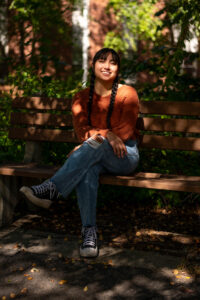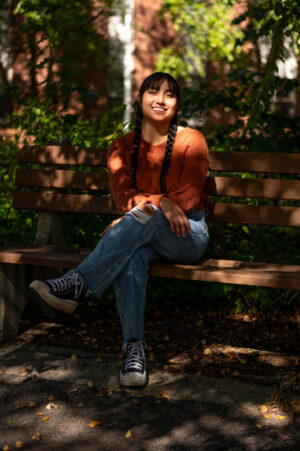Liliana Sapiel
By Dakota Eddy, News Editor
One of the amazing things about USM is the continuous effort to make sure all groups of students feel seen and heard. Through Intercultural Student Affairs, students can start Affinity Groups to provide a safe space for growth, learning, and being able to share your culture and identity with others.

Liliana Sapiel, a second-year student from the Passamaquoddy and Penobscot tribes, came to USM looking to build a supportive community for Indigenous students. Due to the COVID-19 pandemic, the previous Affinity Group for Indigenous students was no longer active. Sapiel saw this, and decided to restart the Student Alliance of Indigenous Peoples group with another student to give Indigenous students a place to practice their culture, while also giving other like-minded students the opportunity to learn about Indigenous cultures. I’m grateful to have had the opportunity to sit down with Sapiel to learn more about her role in the Student Alliance of Indigenous Peoples.
Q: What is your major?
A: Political Science.
Q: Why did you choose that as your major?
A: I’m going into law, so it’s kind of like a pre-law track.
Q: Why did you choose USM?
A: Originally, I didn’t choose USM. I took two gap years, and just realized I wanted to go back to school. It was kind of the closest school, and I also saw that there wasn’t a club, so I was interested to start my own, so I had that safe space.
Q: What does the Student Alliance for Indigenous Peoples offer for students?
A: Our club is open to everybody, but we wanna use the club as a safe space for all Indigenous students. We have that safe space so that we can practice our culture, which is ceremonies, traditions, and finding like-minded individuals who may not have grown up on a reservation, or who aren’t really close to the community but want to reconnect, but also just having the space open to those people who just want to learn more about Indigenous people and culture. We also do outreach work, so we do want to go back into the communities, like local reservations and help out, whether that looks like going into the schools and talking about our club, or volunteering for local food sovereignty programs to give back to the Wabanaki communities.
Q: What is your role in the SAIP?
A: We’re like a board, so I’m a Board Member, there is no President or anything like that.
Q: How has the SAIP shaped your experience at USM? What is your favorite part about being a part of the SAIP?
A: I feel like if it wasn’t for the club, my USM experience would be so different. It gave me a sense of community, and purpose here at USM. It made me want to go to more events to help spread the awareness about our club, so it really helped me become a part of the USM community.
Q: What do you do outside of classes?
A: Mostly, the club. It keeps me really busy, but otherwise, I’m just hanging out with friends when I have the time.
Q: What is your inspiration?
A: My mom is probably my biggest inspiration. She had us when she was younger, and raised us while going through college, so I kind of got that college experience through her. She was a middle school drop-out, and she got her Masters degree. It really showed me that no matter how hard schooling is, she was still able to pull through and make her dreams come true.
Q: What are your plans for after USM?
A: Well, I’m going to law school, so I’ll be doing that for a little bit. I want to be a tribal lawyer, so hopefully going back to my community on the reservation where I grew up.
Q: Do you have any advice for others?
A: Definitely find that little niche – that little community inside the community. I feel like it’s easy to get lost and feel lost and lonely. Finding those like-minded individuals, that’s how you make friends.
Q: When you look back on your time with USM, what will you remember?
A: I mean, the club! Probably my teachers too, I really like all of my teachers. But yeah, the club members, and the legacy that I’m working so hard to build. I want to come back hopefully five or ten years down the road and have that club still be there and doing activities. I put a lot of hard work into this club so students like me can have that space.


Leave a Reply